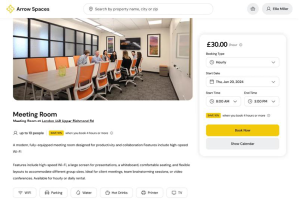Monetise Bandwidth: How Tiered Offerings Provide Net Revenue
One of the biggest drivers of income in a coworking space is the bandwidth you offer your members. For this reason, it is imperative to note how to maximise the revenue from your bandwidth, while providing ample options for all members.
First, understand that the majority of coworking space revenue comes from private offices or companies, not individual members renting out desk space. So how are you currently dividing up your bandwidth packages? In an “all you can eat” scenario, everyone has equal access to as much bandwidth as can be provided. While this could be an entry level approach to offer members, keep in mind that the vast majority of your bandwidth, like your revenue, is allocated to the companies, private offices and conference rooms in your space. For an individual member who is mostly emailing, surfing the web and taking occasional Zoom calls, this entry level bandwidth package offering is sufficient.
Tiered service plans
“Because companies and offices are taking up so much of the bandwidth, they need to be charged accordingly, so we step into the service plan level,” explains Paul Orrock, Yardi’s regional manager and Medusa Wi-Fi specialist.
This concept guarantees a level of bandwidth for those willing to pay for it. Guaranteed bandwidth is a level that is always available when needed, but able to be used by others when not needed. The Yardi Medusa platform allows you to allocate guaranteed service as needed.
“A company or private office is going to be using a larger proportion of the bandwidth than individual members from a dollar per megabyte standpoint,” Orrock added. “So essentially they are being subsidized by the other users.”
This is a simple conversation with your prospective members before they move into your space. Through a discovery process, you should be able to learn what type of company they are and what work they do, to determine how much bandwidth they will likely need.
Build out an appropriate tiered system. You could have three basic levels, for example. The first level could be your basic “all you can eat” package, as described earlier. A second level would add bandwidth for those who need to download and upload larger files and other data-heavy activity. This may represent a smaller portion of your member-base, but a larger percentage of your revenue. A third, or top level, would be for an exclusive group of your highest data users. Analyze how much bandwidth you have overall, to be able to know how to divide up the entry level offering and the higher bandwidth levels.
A possible way to describe the entry level is ‘good for web, email and an occasional Netflix show’. Tier two could be ‘good for interactive applications and VPNs or online data storage like Dropbox or OneDrive’ and a tier three could be ‘consistent video conferencing and live financial trading’. A top tier plan as compared to a standard 10 Mbps service could offer up to 30x the speed.
Fair use restrictions
Companies have mobile app needs that may not just require a minimum bandwidth level, but also other performance requirements such as latency or jitter. Poorly configured internet service can mean applications fail to perform well. “You need to make sure the bandwidth you’re offering meets the requirements, but if they’re introducing any sort of impediments into that solution, such as a VPN or a firewall, they need to be responsible for that,” Orrock said. The operator needs to articulate this very clearly to the client upon signed agreement.
A “fairness rule” on shared plans is often applied to ensure there is no hogging of the resource. Let’s say, for example, your entry level package offers users 10 Mbps. The Medusa platform has the ability to limit these users to the given 10 Mbps to prevent violation of terms in addition to hogging the bandwidth. Analyze the reporting data from your service provider in real-time as well as historically, to see which users are consuming the most and whether they are abusing the offering intentionally or unintentionally. Often times, this becomes a revenue opportunity. The operator can approach the member with a discussion about the fair use policy and when a member is hitting his/her threshold repeatedly, they will likely elect to jump to your next tier offering before risking their own productivity.
“Monetisation of your bandwidth provides pure net margin,” Orrock stated. In other words, this is a service you already own and infrastructure that you’ve already paid for. Any extra revenue you get from tiered packages is net revenue. Your staff also need to understand the basics of bandwidth management. They need to be able to articulate information to a prospect or member to avoid confusion or unanswered questions. Don’t make the tiered offerings more complex that they need to be, so that it is very simple to members and staff.
Companies often elect to bring their own voice technology into your space and there are easy ways to monetise this too, offsetting lost call revenues to the centre. Remind the member that you do provide voice, so if they choose to use a competitor service while on your bandwidth, there needs to be a fee associated, or a jump to a higher tier plan.
The Medusa platform provides tools to help customers analyse their needs and design the best bandwidth monetisation policies. If you ensure than your base offering satisfies the majority of your individual members and you build up accordingly thereafter, you will see a consistent stream of net revenue.





